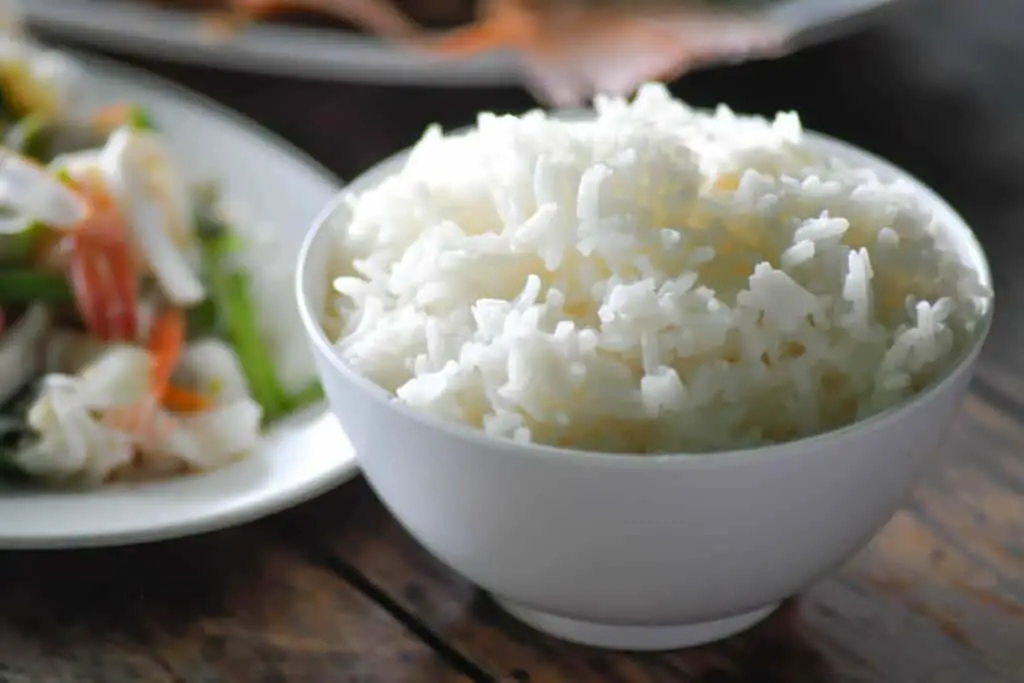
Adobo is a dish that’s traditionally made with pork or chicken as the main ingredient. Because the dish is so heavy on meat, you may be wondering what types of food can you serve as a side dish or a complimentary dish to adobo to make it a well-rounded meal. This article talks about the most common side dishes that Filipinos like to eat with adobo.
Rice

Filipino adobo is a dish that is traditionally made with chicken or pork that has been simmered in a vinegar and soy sauce mixture. Rice is often served as a side dish with adobo, and the two flavors complement each other very well. The rice helps balance out the richness of flavor in adobo, while the strong flavors of vinegar and soy sauce add life to a bowl of otherwise plain-tasting rice. The result is a dish that is savory and satisfying. Additionally, rice is a good source of carbohydrates, which help to round out a meal. For these reasons, it is no wonder that rice and adobo are often served together.
Vegetables
There are a few reasons why vegetables taste especially good when eaten with Filipino adobo. First, the vinegar in adobo helps to brighten the flavors of the vegetables. Second, the spices in adobo add a depth of flavor that complements the natural, subtle sweetness of some vegetables. Finally, the richness of the adobo sauce helps to round out the flavors of the vegetables. Together, these factors make for a delicious and satisfying dish.
Instant Noodle Soup
Eating adobo with instant noodle soup is not something that all Filipinos do. However, from experience, many common Filipino folks often eat instant noodle soup with adobo from time to time, myself included. The reason why this combination is so popular is because adobo is, by nature, quite a dry dish. For Filipinos that are accustomed to eating soups, eating a dry dish by itself sometimes feels like something is missing. Adding instant noodle soup to the menu adds that soup base that many Filipinos crave, whether consciously or not.
Salted Egg and Tomato
There are a few reasons why salted egg and tomato go so well together in Filipino adobo dishes. First, the saltiness of the egg helps to balance out the acidity of the tomatoes. Second, the fat in the egg yolks helps to coat the tongue and round out the flavors of the dish. Finally, the rich savory flavor of the egg yolks complements the savory notes of the adobo sauce. Together, these factors create a dish that is both delicious and deeply satisfying. So next time you’re craving adobo, be sure to add a few salted eggs to the mix.
Hardboiled Egg

Hardboiled eggs are quite a staple in Filipino everyday cuisine. This food is so simple, yet also so versatile that it can be eaten as is or used as an ingredient in other dishes. One popular way to enjoy hardboiled eggs is to eat them with Filipino adobo. Adobo is a dish made with vinegar, soy sauce, and garlic, and it is often used as a marinade or sauce for meats. The combination of the salty, tangy adobo with the rich, creamy egg yolks creates a delicious contrast of flavors that is sure to please any palate. So if you’re looking for a new way to enjoy your adobo, try adding one or two hardboiled egg to the dish. You won’t be disappointed.
Lumpia
Lumpia is a dish that originates from the Philippines. It consists of an eggroll wrapper filled with a variety of fillings, which can include meat, vegetables, and noodles. Lumpia is often served as an appetizer or main dish, and it is sometimes eaten with Filipino adobo. Many people enjoy eating lumpia with adobo because the savory flavors of the dish complement each other perfectly. The adobo sauce helps to elevate the flavor of the lumpia, and the herbs and spices in the adobo add an extra layer of depth to the dish. When paired together, lumpia and adobo make for a delicious and satisfying meal.
Chop Suey
There are many different theories about why chop suey tastes good when eaten with Filipino adobo. One theory is that the acidity of the vinegar in adobo helps to balance out the richness of the dish. Another theory is that the salty soy sauce complements the sweetness of the hoisin sauce in chop suey. Whatever the reason, there’s no denying that these two dishes are a perfect match. When eaten together, they create a delicious and complex flavor that is sure to please any palate. So next time you’re looking for a quick and easy meal, be sure to give chop suey and adobo a try. You won’t be disappointed.
What veggies goes with adobo?
There are plenty of different vegetables that go well with adobo. In this section, we will discuss the most popular vegetables that Filipinos like to eat with adobo.
Talbos ng Kamote (Yam Leaves)

Talbos ng kamote, or Philippine sweet potato leaves, are a common ingredient in Filipino dishes. The leaves are typically cooked by blanching it in boiling water. Cooking it this way brings out its aroma and the slightly slimy, yet sweet taste. When talbos ng kamote is eaten with adobo, the dish takes on a delicious sweetness. It is thought that the combination of the savory flavors of the adobo with the natural sweetness of the yam leaves creates a unique and delicious taste. Additionally, the kamote leaves help to balance out the rich flavors of the adobo, making it a more well-rounded dish. As a result, talbos ng kamote is a popular choice for those looking to add a bit of sweetness to their adobo dish.
Okra

Okra is a plant that is native to the Philippines. The plant is grown for its edible green pods, which are used in many different cuisines. Okra is often cooked with other vegetables, such as tomatoes and onions. In the Philippines, okra is commonly cooked blanched in boiling water. Okra tastes delicious when eaten with chicken or pork adobo. This is because okra has a subtle flavor, which compliments the rich flavor of adobo quite nicely. The combination of these two dishes results in a tasty and satisfying meal.
Spinach

For those that live abroad, outside the Philippines, it might be difficult to come by yam leaves or okra. Sometimes, the best alternative is spinach. Spinach is a widely available leafy green that can be comparable to talbos ng kamote, or yam leaves. This is why spinach is also a popular vegetable to eat with adobo, because it is a great substitute for yam leaves. Spinach is usually cooked by blanching it in boiling water, and served plainly with adobo. Spinach can be an acquired taste for some, but the taste of the vinegar and soy sauce in adobo helps to enhance the flavor of the spinach leaves.

